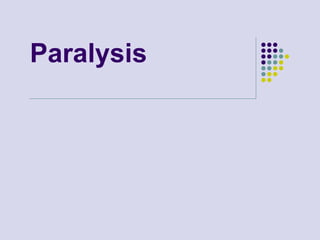
Paralysis
- 1. Paralysis
- 2. What is paralysis? Paralysis is caused by spinal cord injury (SCI). All control is lost below the point of the break in the cord because the synapse connection is broken. This causes calcium ions to start entering the neurons. The membrane outside these cells is broken, allowing the release of phospholipase, which is an enzyme that digests tissue. To counter this, free radicals, which are just atoms that are missing an electron in the outer layer, are released. The problems is, the free radicals attack nearby neurons that are perfectly healthy. When they attack, they cause the lipids to break down into oxygen. When this happens, teh cells swell up and release glutamate, a neurotransmitter that is toxic in great amounts. The bottom line is that massive amounts of damage are caused to the nervous system. Paraplegia and Quadraplegia Paraplegia and quadraplegia are the two main types of SCI. These two classes are used to define the severity and type of paralysis. Quadraplegia is the more serious of the two types. Quadraplegia is where injury occurs from the neck down and usually disables the ability of the arms and legs to move.
- 3. Paraplegia is a little less sever and is defined as an injury to the spinal cord at about the waist level. This injury usually only disables the legs ablities to move. Most Quadraplegia SCI injurys are caused in car accidents, diving, and falls, while Paraplegia is usually caused by acts of violence and less severe car accidents. The injury rate for both types of injurys are about the same. Paralysis Statistics Source: Spinalcord Information Network 82% male, 18% female Most injury occurs between ages 16-30 Average age at injury - 33.4 Most frequent age at injury 19 Motor vehicle accidents are the leading cause of SCI (44%), followed by acts of violence (24%), falls (22%) and sports (8%), other (2%) 2/3 of sports injuries are from diving
- 4. Falls are the leading cause of SCI after age 45. Acts of violence and sports cause less injuries as age increases Type of Paralysis: Incompleted defined as injurys where loss of ability to move is partial below the injury point on spinal cord. Complete is defined as loss of total funtion below injury point on spinal cord. Quadriplegia, incomplete 31.2% Paraplegia, complete 28.2% Paraplegia, incomplete 23.1% Quadriplegia, complete 17.5% Average Medical Bills for an SCI Patient Quadriplegics $118,900 Paraplegics $ 85,100 All $ 99,553
- 5. Where the Money Comes From: Private Insurance 53% Medicaid 25% Self-pay 1% Vocational Rehab 14% Worker's Comp 12% Medicare 5% Other 2% Overall, 85% of SCI patients who survive the first 24 hours are still alive 10 years later. Is There a Cure? No cure to Paralysis in either of its forms, paraplegia and quadraplegia, has been found.
- 6. Research is currently being done with rats in test labs which have proved to be successful. Using growth hormones, specifically designed for nerve cells, damage to the rats spinal cord was healed, and the rats could walk again on their hind legs, an incredible feat. Now as this procedure has not worked with humans, since it would take a massive amount of hormones to stimulate growth, it is a start and a hope for a cure to paralysis. Christopher Reeve (Shown to the right) is one of the leading figures in the race to cure paralysis. His organization, The Christopher Reeve foundation, leads funding for research into a cure for paralysis.
- 7. POSTED BY ATTORNEY RENE G. GARCIA: For more information:- Some of our clients have suffered this kind of injuries due to a serious accident. The Garcia Law Firm, P.C. was able to successfully handle these types of cases. For a free consultation please call us at 1-866- SCAFFOLD or 212-725-1313. http://www.tjhsst.edu/~jleaf/disability/elequipo/
